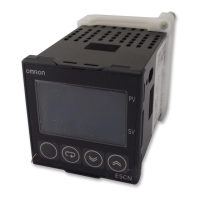60
Using Heater Burnout, Heater Short, and Heater Overcurrent Alarms Section 3-10
PV Change Rate Alarm The change width can be found for PV input values in any set period. Differ-
ences with previous values in each set period are calculated, and an alarm is
output if the result exceeds the alarm value. The PV rate of change calculation
period can be set in units of 250 ms.
If a positive value is set for the alarm value, the PV will operate as a change
rate alarm in the rising direction. If a negative value is set, the PV will operate
as a change rate alarm in the falling direction.
Precaution
If a shorter PV rate of change calculation period is set, outputs set for the PV
change rate alarm function may repeatedly turn ON and OFF for a short
period of time. It is therefore recommended that the PV change rate alarm be
used with the alarm latch turned ON.
3-10 Using Heater Burnout, Heater Short, and Heater
Overcurrent Alarms
3-10-1 Heater Burnout, Heater Short, and Heater Overcurrent Alarm
Operations
• Heater burnout detection and heater overcurrent detection are executed
by measuring heater current while the control output (heating) is ON, and
heater short detection is executed by measuring heater current while it is
OFF. For details, refer to the following table. (Heater burnout detection,
heater short detection, and heater overcurrent detection cannot be used
with the control output for cooling.)
Parameter name Setting range Unit Default
PV Rate of Change Calcu-
lation Period
1 to 999 Sampling cycle 4 (1 s)
PV
Alarm value
Time
PV change width for PV rate
of change calculation period
Alarm function
OFF
ON
OFF
ON
0
Control output (heating) status Power to heater HB alarm
output
HS alarm
output
Heater overcurrent
alarm output
Control output
(heating)
Operation
indicator
ON Lit Yes (Normal) (See note 1.) OFF --- ---
No (Heater burnout) ON --- ---
OFF Not lit Yes (HS alarm) --- ON ---
No (Normal) (See note 2.) --- OFF ---

